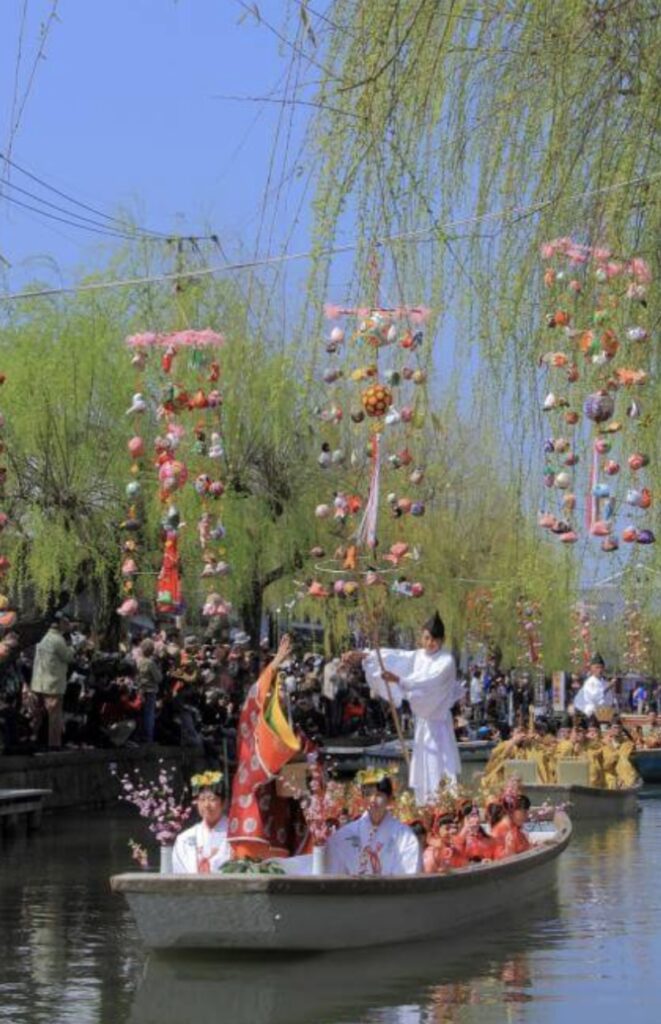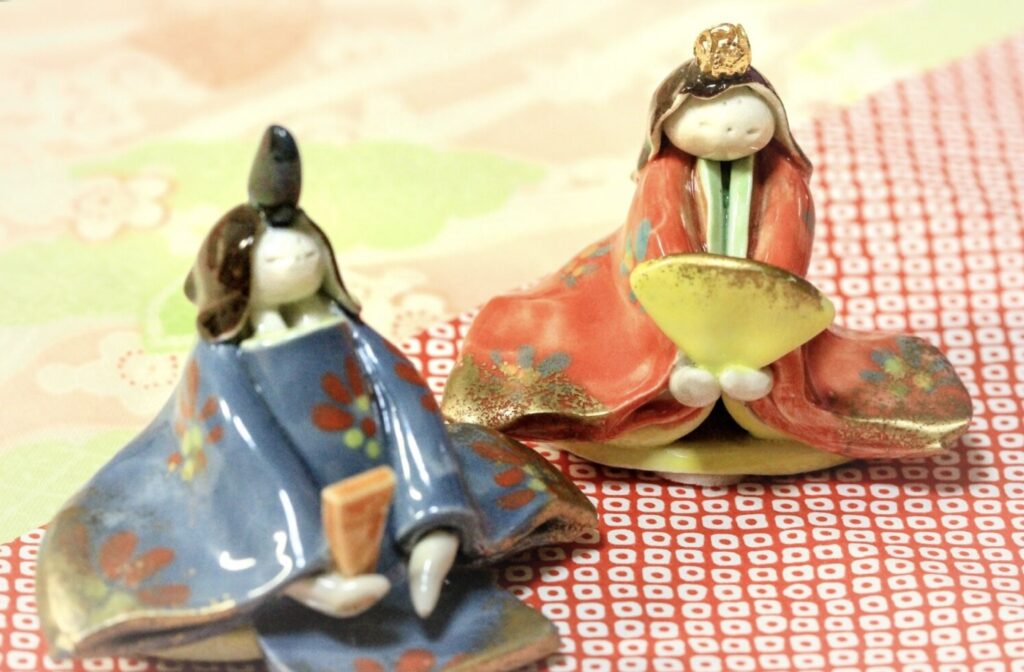ChatGPT:
Hinamatsuri, also known as Doll’s Day or Girls’ Day, is a traditional Japanese festival celebrated on March 3rd. The festival is dedicated to the well-being and happiness of girls and involves displaying a set of ornamental dolls called hina-ningyo, which represent the Emperor, Empress, attendants, and musicians of the Heian period court.
Origin
The origins of Hinamatsuri date back to the Heian period (794-1185), where it is believed to have evolved from an ancient custom called “hina-asobi,” a form of doll play. Another key influence is the purification ritual “hina-nagashi,” where straw dolls are set afloat on a river to carry away bad spirits.
Unique Features
- Hina Doll Display: The central feature of Hinamatsuri is the display of hina dolls. These dolls are often arranged on a tiered platform covered with a red cloth. The top tier holds the Emperor and Empress dolls, while the lower tiers contain other court figures and items.
- Food and Drink: Traditional foods enjoyed during Hinamatsuri include hina-arare (colored rice crackers), chirashizushi (scattered sushi), and shirozake (sweet white sake).
- Peach Blossoms: Peach blossoms are commonly used in decorations, symbolizing a happy marriage and a bright future.
- Customs and Celebrations: Families with young girls celebrate by setting up the hina doll display in their homes and praying for the girls’ health and happiness. Some communities also have public celebrations, parades, and various events.
Hinamatsuri is a beautiful celebration that reflects Japan’s cultural heritage and its deep-rooted customs of celebrating life and well-being.
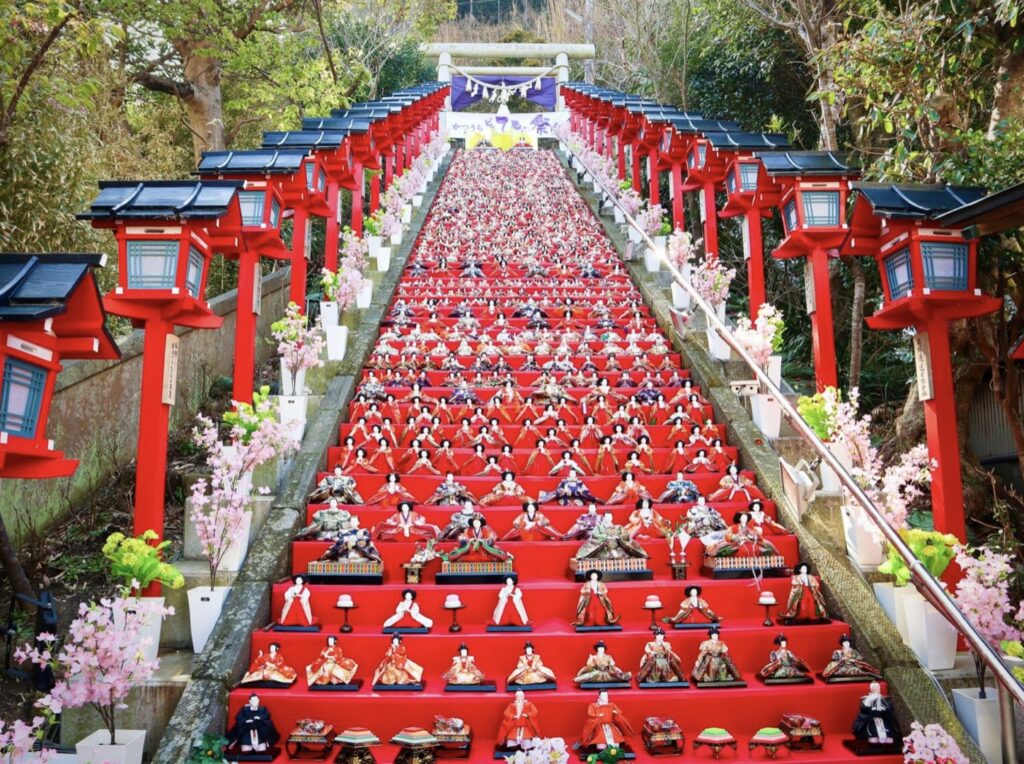
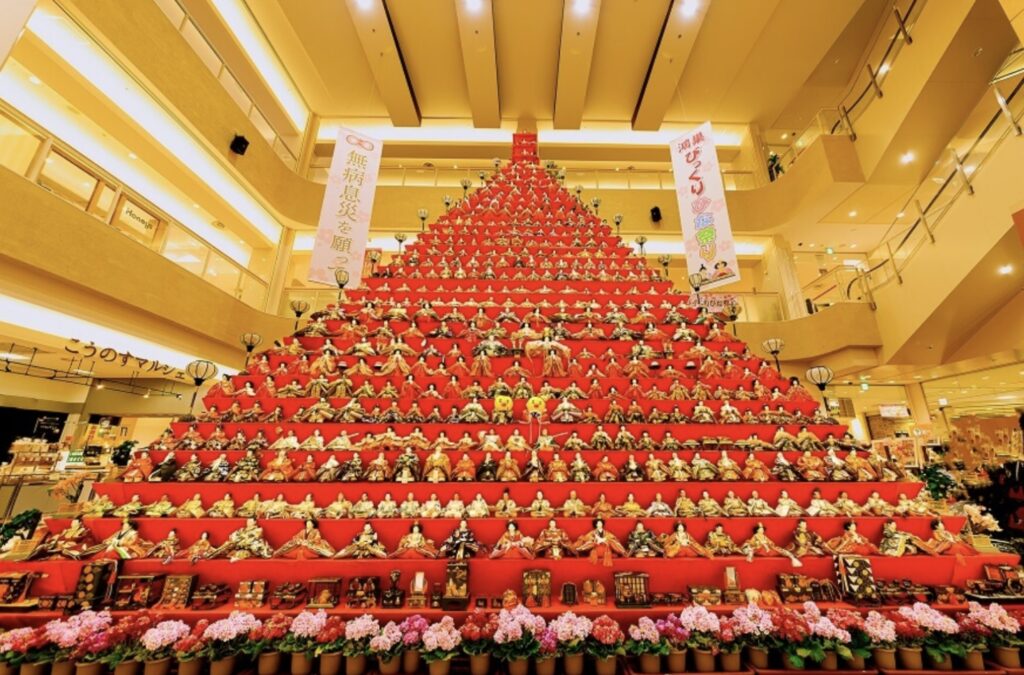
The Hina Doll display, known as “hinadan,” is an elaborate and traditional setup used during Hinamatsuri. The display consists of a tiered platform, usually covered with a red cloth called “hi-mōsen,” and holds a variety of hina dolls and miniature accessories. Here’s a detailed description of each tier and the dolls and items typically placed on them:
1. Top Tier (First Tier)
- Emperor and Empress (Dairi-bina): The top tier features the Emperor (Odairi-sama) and Empress (Ohina-sama). They are often dressed in traditional Heian period court robes. The Emperor holds a ritual baton or a fan, and the Empress holds a fan or may also have a small table with accessories.
2. Second Tier
- Three Court Ladies (Sannin Kanjo): This tier holds three court ladies who serve the Emperor and Empress. They are often shown holding sake equipment, including long-handled sake jars and small tables with cups.
3. Third Tier
- Five Male Musicians (Gonin Bayashi): Five male musicians are depicted playing traditional Japanese musical instruments. The instruments typically include a small drum (taiko), a large drum (ōtsuzumi), a hand drum (kotsuzumi), a flute (fue), and a singer (utaikata).
4. Fourth Tier
- Two Ministers (Udaijin and Sadaijin): This tier features two ministers, often depicted as an old, wise man (right minister or Udaijin) and a younger man (left minister or Sadaijin). They are sometimes accompanied by small trays with food.
5. Fifth Tier
- Three Helpers or Samurai (Shicho): Three helpers or samurai are depicted on this tier, often with expressions that suggest they are serving and protecting the imperial household. They may hold items like swords or small tables.
6. Sixth and Seventh Tiers
- Miniature Furniture and Household Items: The lower tiers are filled with various miniature furniture and household items. These can include:
- Palace Furniture (Dōgu): Miniature chests of drawers, sewing kits, and other household items.
- Carriages and Chests: Ox-drawn carriages, palanquins, and chests used for transporting the imperial household’s belongings.
Additional Details
- Decorations and Accessories: The display may also include additional decorative items such as small lanterns (bonbori), a tiny garden with cherry or peach blossoms, and folding screens (byōbu) placed behind the Emperor and Empress.
- Significance and Placement: The placement of the dolls and items on the tiered platform follows a specific order, symbolizing their rank and role in the imperial court. The setup reflects a miniature representation of the Heian court, showcasing the cultural and artistic traditions of that period.
The hinadan is not only a centerpiece for Hinamatsuri celebrations but also a beautiful work of art that embodies Japanese heritage, craftsmanship, and the wish for the health and happiness of girls.
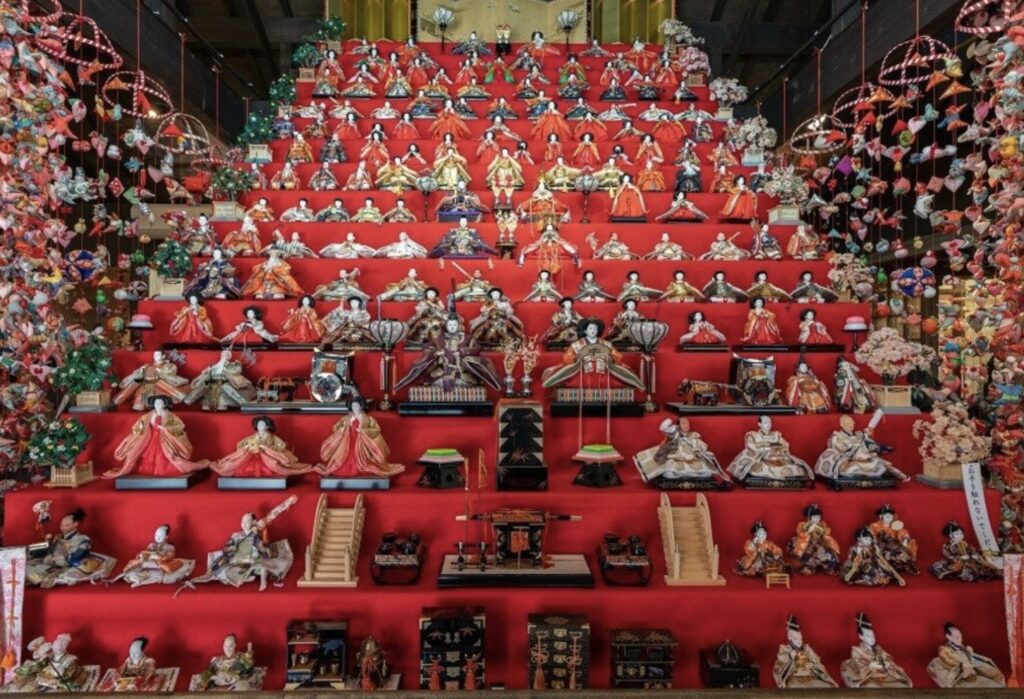
Hinamatsuri is still widely celebrated in Japan today. It remains an important cultural event, especially for families with young girls. Here are some ways Hinamatsuri is celebrated in modern times:
Family Celebrations
- Doll Displays: Many families with daughters continue to set up hina doll displays in their homes. These displays are often passed down through generations and are carefully arranged each year.
- Traditional Foods: Families prepare and enjoy special foods associated with Hinamatsuri, such as chirashizushi (scattered sushi), hina-arare (colorful rice crackers), and hishimochi (diamond-shaped rice cakes). Sweet white sake (shirozake) is also traditionally served.
- Prayers for Girls: Parents and grandparents pray for the health, happiness, and successful future of their daughters and granddaughters.
Public Celebrations
- Festivals and Events: Many communities and cultural organizations host public events and festivals to celebrate Hinamatsuri. These can include parades, cultural performances, and exhibitions of elaborate hina doll displays.
- Educational Activities: Schools and cultural institutions often hold activities to educate children about the history and traditions of Hinamatsuri, including crafting workshops where children can make their own hina dolls.
- Temple and Shrine Events: Some temples and shrines hold special ceremonies and events to mark Hinamatsuri. These can include traditional music performances, tea ceremonies, and displays of hina dolls.
Commercial Aspect
- Merchandising: Shops and department stores sell a variety of Hinamatsuri-related items, including hina dolls, decorations, and themed sweets. Seasonal displays and promotions are common in the weeks leading up to March 3rd.
- Tourism: Certain regions in Japan, known for their traditional crafts and doll-making, attract tourists during Hinamatsuri season. These areas may host special exhibitions and workshops for visitors.
Overall, Hinamatsuri continues to be a vibrant and cherished part of Japanese culture, blending traditional practices with modern celebrations. It serves as a meaningful occasion for families to come together and honor their daughters, while also preserving and promoting cultural heritage.
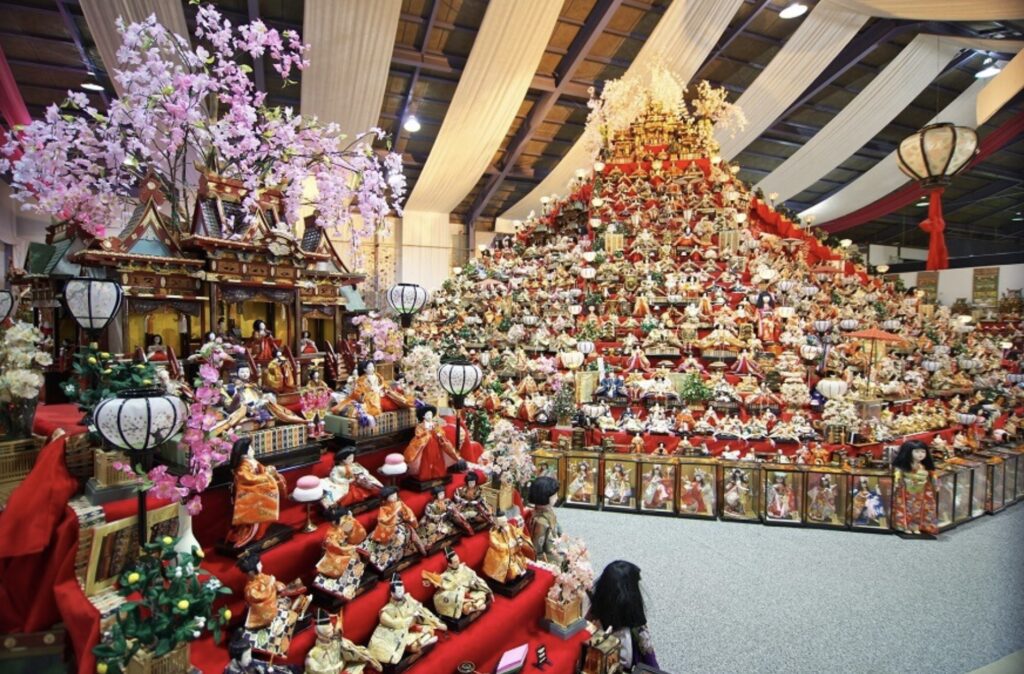
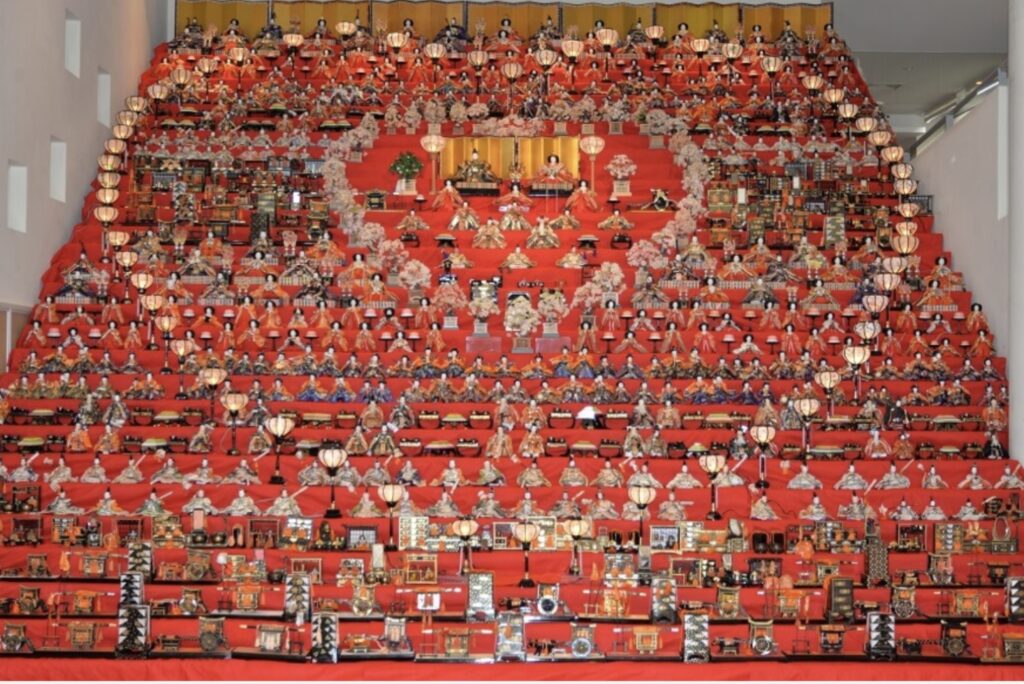
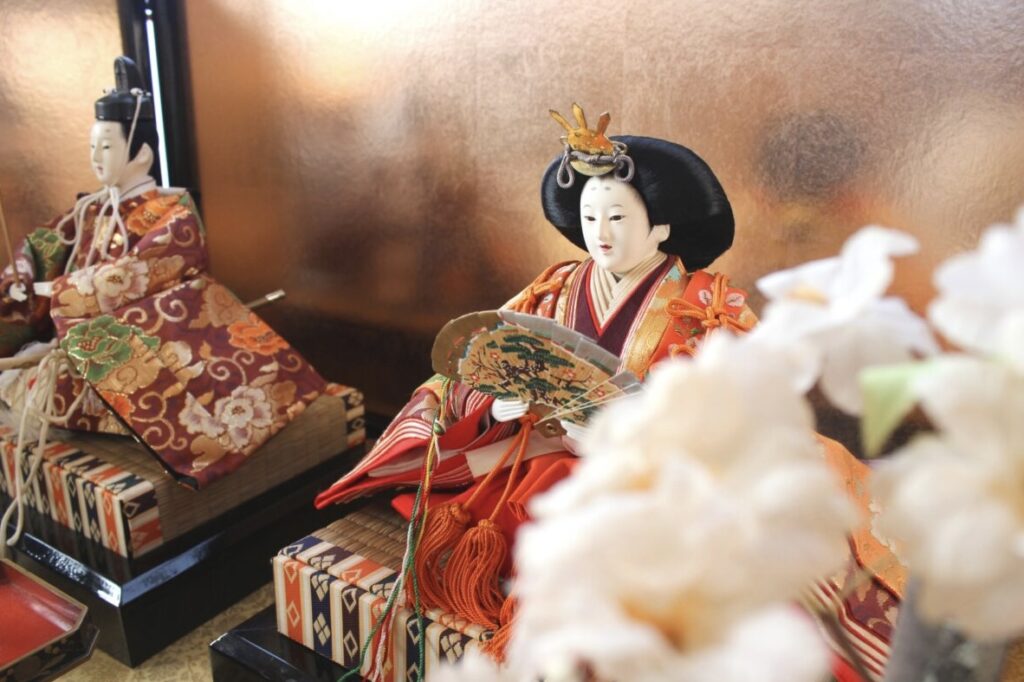
One place in Japan famous for its Hinamatsuri displays is the city of Yanagawa in Fukuoka Prefecture. Yanagawa is renowned for its elaborate and large-scale displays of hina dolls during the festival season.
Yanagawa’s Hinamatsuri
- Sagemon Meguri: Yanagawa’s unique celebration is known as the Sagemon Meguri, which features colorful hanging decorations called “sagemon” in addition to traditional hina doll displays. These sagemon are handmade decorations crafted from silk fabric and are hung alongside the hina dolls to bring good fortune to young girls.
- Public Displays: During the Hinamatsuri season, many households and public venues in Yanagawa exhibit their hina doll collections and sagemon. The city organizes walking tours, allowing visitors to explore various locations showcasing these beautiful displays.
- Cultural Events: Yanagawa also hosts various cultural events and activities during Hinamatsuri, including traditional performances, boat rides along the city’s famous canals, and workshops where visitors can learn to make their own sagemon.
Yanagawa’s dedication to preserving and celebrating the traditions of Hinamatsuri makes it a popular destination for tourists and cultural enthusiasts, offering a unique and immersive experience of this cherished Japanese festival.
